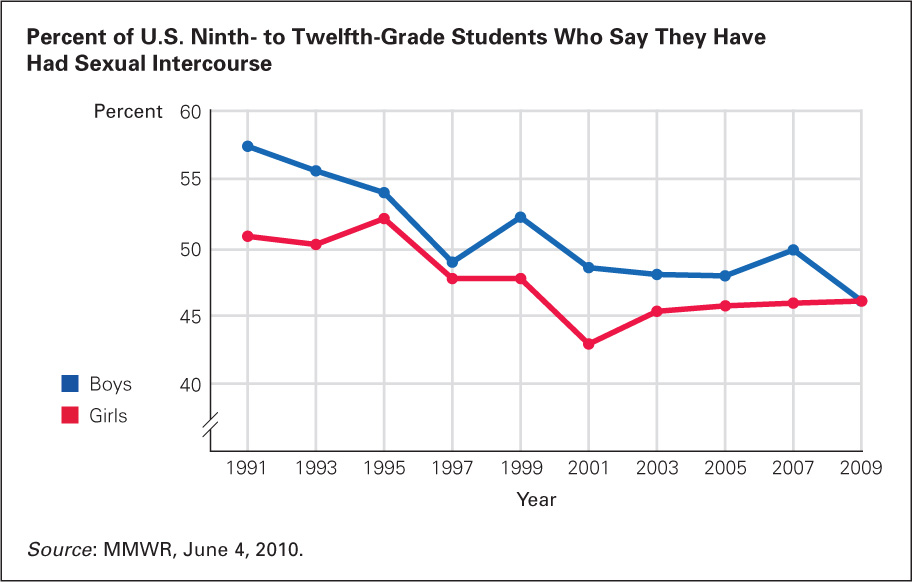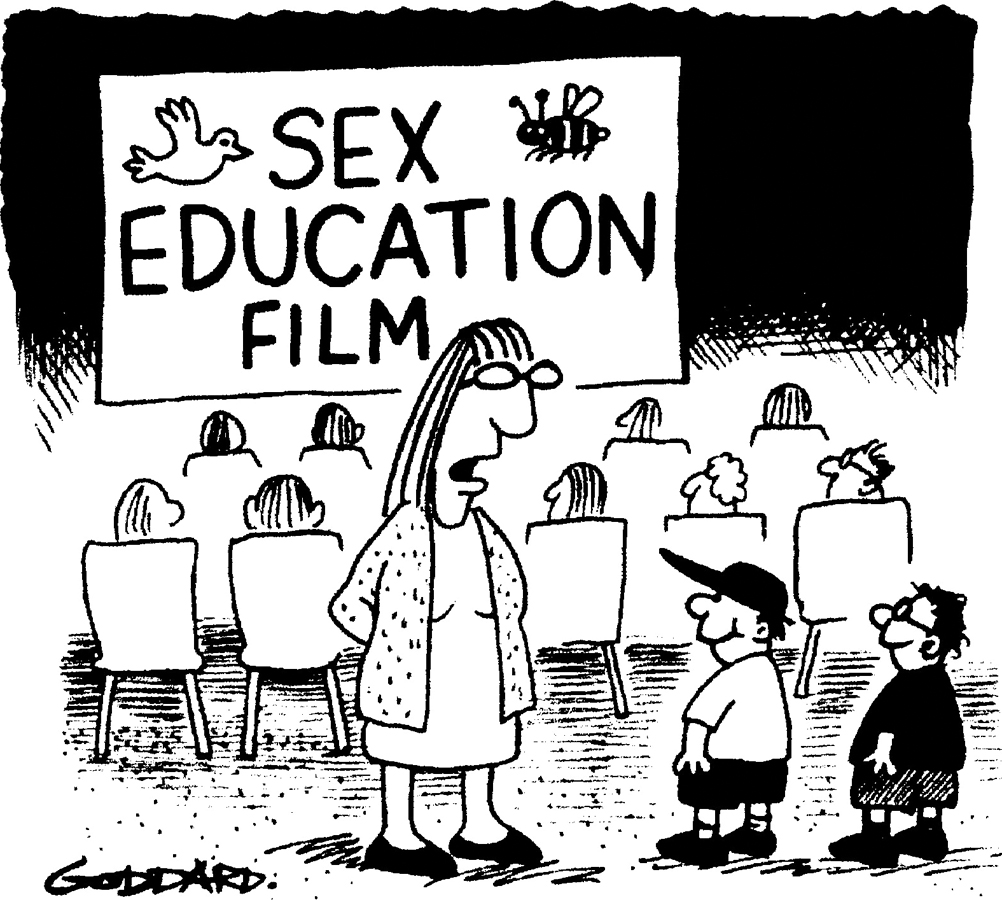14.4 Sexual Maturation
Sexuality is a complex aspect of human development. Here we consider biological changes at puberty and some of the cultural variations and implications. Variations are discussed again in later chapters.
Sexual Characteristics
primary sex characteristics The parts of the body that are directly involved in reproduction, including the vagina, uterus, ovaries, testicles, and penis.
The body characteristics that are directly involved in conception and pregnancy are called primary sex characteristics. During puberty, every primary sex organ (the ovaries, the uterus, the penis, and the testes) increases dramatically in size and matures in function. By the end of the process, reproduction is possible.
420
secondary sex characteristics Physical traits that are not directly involved in reproduction but that indicate sexual maturity, such as a man’s beard and a woman’s breasts.
At the same time that maturation of the primary sex characteristics occurs, secondary sex characteristics develop. Secondary sex characteristics are bodily features that do not directly affect reproduction (hence they are secondary) but that signify masculinity or femininity.
One secondary characteristic is shape. Young boys and girls have similar shapes, but at puberty males widen at the shoulders and grow about 5 inches taller than females, while girls develop breasts and wider hips. Those female curves are often considered signs of womanhood, but neither breasts nor wide hips are required for conception; thus, they are secondary, not primary, sex characteristics.
The pattern of hair growth at the scalp line (widow’s peak), the prominence of the larynx (Adam’s apple), and several other anatomical features differ for men and women; all are secondary sex characteristics that few people notice. As previously explained, facial hair increases in both sexes, affected by sex hormones as well as genes.
Secondary sex characteristics such as hair are important psychologically, if not biologically. Breasts are an obvious example. Many adolescent girls buy “mini-
Sexual Activity
The primary and secondary sex characteristics just described are not the only manifestations of the sex hormones. Fantasizing, flirting, hand-


A recent study on sexual behaviors such as hand-
421
Regarding sex-
Everyone, however, is influenced by hormones and society, biology and culture. All adolescents have sexual interests they did not previously have (biology), which produce behaviors that teenagers in other nations would not engage in (culture). Since only girls can become pregnant, their wish for long-
For whatever reason, the gender gap in experience is narrowing. It has already been reversed in some European nations, including Norway where sex education begins in childhood. By adolescence, Norwegian teenagers currently know how to prevent the unwanted consequences of intercourse. In 1987, Norwegian boys had their first sexual intercourse almost a year younger than girls did; by 2002, the sexes flipped, with girls averaging half a year younger than boys (Stigum et al., 2009).
It may seem that choosing sexual partners and activities is a private and personal matter. Yet culture and cohort dominate, as data on age at first sexual experience make clear.
In some nations girls’ first partners are significantly older, and in other nations that is more true for boys. For most of the twentieth century, surveys in North America reported sexual activity among adolescents of both sexes at younger and younger ages. That trend has reversed in recent decades: first sex is now at older ages.

One statistic illustrates this new trend. In 1991, 62 percent of U.S. eleventh-
The trend toward later sexual activity among adolescents is worldwide, although in many nations, as marriage age has become later, premarital sex is more common—
During the same time period, the double standard (boys expected to be more sexually active than girls) narrowed in every ethnic group. Ethnic differences in sexual activity are narrowing as well, with every group less sexually active. Between 1991 and 2011, intercourse experience among African American high school students decreased 26 percent (from 81 to 60); among European Americans, it was down 12 percent (from 50 to 44); and among Latinos, it was down 7.5 percent (from 53 to 49) (MMWR, June 8, 2012).
All these examples demonstrate that a universal experience (rising hormones) that produces another universal experience (growth of primary and secondary sex characteristics) is influenced by cohort, gender, and culture. Other research finds that the most powerful influence on adolescent sexual activity is close friends, not national norms for their sexual or ethnic group. [Lifespan Link: The influence of peers on adolescent sexual activity is discussed in Chapter 16.]
422
Problems with Adolescent Sex
Sexual interest and interaction are part of adolescence; healthy adult relationships are more likely to develop when adolescent impulses have not been haunted by shame and fear (Tolman & McClelland, 2011). Although guidance is needed, teenagers are healthy and normal, not depraved or evil, in experiencing sexual urges. Before focusing on the hazards of adolescent sex, we should note that several “problems” are less troubling now than in earlier decades. Here are three specifics:
- Teen births have decreased in every nation. Teen births have been declining in most countries over the past few decades (World Health Organization, March 19, 2012). In the U.S., births to teenaged mothers (aged 15 to 19) decreased 25 percent between 2007 and 2011 across race and ethnicity, with the biggest drop among Hispanic teens (Martin et al., 2010; CDC, 2013). Similar declines are evident in other nations. In China, the teen pregnancy rate was cut in half from 1960 to 2010 (reducing the United Nations’ projections of the world’s population in 2050 by about 1 billion).
- The use of “protection” has risen. Contraception, particularly condom use among adolescent boys, has increased markedly in most nations since 1990 (Santelli & Melnikas, 2010). The U.S. Youth Risk Behavior Survey found that 67 percent of sexually active ninth-
grade boys had used a condom during their most recent intercourse (MMWR, June 8, 2012). - The teen abortion rate is down. In general, the teen abortion rate in the United States has declined every year since abortion became legal. The rate today is about half that of 20 years earlier (Kost et al., 2013), even as the rate among older women has increased. Internationally, however, abortion rates among teenagers are very difficult to track. An estimated three million girls aged 15 to 19 undergo unsafe abortions each year, mostly in low-
and middle- income countries (WHO, 2012).
These are positive trends, but many aspects of adolescent sexual activity remain problematic.
Sex Too Soon
Sex can, of course, be thrilling and affirming, providing a bonding experience. However, compared to a century ago, adolescent sexual activity—
- Earlier puberty and weaker social taboos mean teens have sexual experiences at younger ages. Early sex correlates with depression and drug abuse.
- Most teenage mothers have no husbands to help them. A century ago, teenage mothers were married; now, in the United States, 85 percent are unwed.
- Raising a child has become more complex and expensive, and most young grandmothers are employed, so fewer of them can help.
- Sexually transmitted infections are more common and dangerous.
As you just read, teen births are declining, as are teen abortions. However, the U.S. rate of adolescent pregnancy is the highest of any developed nation (true among every ethnic group). Such pregnancies are risky. If a pregnant girl is under 16 (most are not), she is more likely than teenagers who are a year or two older to experience complications—
423

There are many reasons in addition to age for these hazards. Poverty and lack of education correlate with teenage pregnancy and with every problem just listed (Santelli & Melnikas, 2010). Beyond that, younger pregnant teenagers are often malnourished and postpone prenatal care (Borkowski et al., 2007). After birth, adolescents are less often the responsive mothers that newborns need, so insecure attachment is more common. [Lifespan Link: Attachment types and the importance of early attachment were discussed in Chapter 7.]
Even without pregnancy, teenagers who have early intercourse risk psychosocial problems. A study of 3,923 adult women in the United States found that those who voluntarily had sex before age 16 were more likely to divorce later on, whether or not they became pregnant or later married their first sexual partner. The same study found that adolescents of any age whose first sexual experience was unwanted (either “really didn’t want it” or “had mixed feelings about it”) were also more likely to later experience divorce (Paik, 2011).
Forced sex is much worse, of course, as now explained.
Sexual Abuse
child sexual abuse Any erotic activity that arouses an adult and excites, shames, or confuses a child, whether or not the victim protests and whether or not genital contact is involved.
Teenage births are risky, but sexual abuse is devastating: It harms development lifelong. Child sexual abuse is defined as any sexual activity (including fondling and photographing) between a juvenile and an adult, with age 18 the usual demarcation (although legal age varies by state). Girls are particularly vulnerable, although pubescent boys are also at risk.
Especially for Parents Worried About Their Teenager’s Risk Taking You remember the risky things you did at the same age, and you are alarmed by the possibility that your child will follow in your footsteps. What should you do?
Response for Parents Worried About Their Teenager’s Risk Taking: You are right to be concerned, but you cannot keep your child locked up for the next decade or so. Since you know that some rebellion and irrationality are likely, try to minimize them by not boasting about your own youthful exploits, by reacting sternly to minor infractions to nip worse behavior in the bud, and by making allies of your child’s teachers.
The rate of sexual abuse increases at puberty, a particularly sensitive time because many young adolescents are confused about their own sexual urges and identity (Graber et al., 2010). Virtually every adolescent problem, including pregnancy, drug abuse, eating disorders, and suicide, is more frequent in adolescents who are sexually abused.
This is true worldwide. The United Nations reports that millions of girls in their early teens are forced into marriage or prostitution (often across national borders) each year (Pinheiro, 2006). Almost every nation has laws against child sexual abuse, but these laws are rarely enforced, and sensationalism about a single horrific case often crowds out systemic efforts to prevent, monitor, and eliminate sexual trafficking (Davidson, 2005).
424
Unfortunately, the people most likely to sexually abuse a young person are family members, who typically isolate the victim, depriving him or her of the friendships and romances that aid in developing a healthy and satisfying life. Young people who are sexually exploited tend to fear sex and to devalue themselves lifelong.
A longitudinal study of 84 reported victims (all girls) of child sex abuse included interviews with each of them six times over 23 years (Trickett et al., 2011). In order to isolate the effects of abuse, the researchers also followed the development of individuals from the same backgrounds (SES, ethnicity, and so on) who were not sexually abused.
Every trait examined (from those directly involving sex to more general social or cognitive accomplishments) showed a far higher incidence of problems in the victims than in their nonvictimized peers. Problems included attitudes directly related to abuse (e.g., most of those abused by their biological fathers thought of sex as dirty, shameful, and dangerous) and behaviors seemingly unconnected (e.g., although their body weight was in the normal range in childhood, 42 percent were obese in their 20s). Cognitive development—
Almost half of the girls who were abused became mothers. They had a total of 78 children, 3 of whom died in infancy and 9 of whom were permanently removed from their mothers, who had severely maltreated them. These rates were much higher than rates among the non-
Early in this chapter, we noted that the HPA system regulates puberty and many other physiological responses. Many of the formerly abused women had abnormal HPA regulation, with alteration of their cortisol responses. That condition produced heightened stress reactions in early adolescence but then abnormally low-
Sexually Transmitted Infections
sexually transmitted infection (STI) A disease spread by sexual contact, including syphilis, gonorrhea, genital herpes, Chlamydia, and HIV.
Unlike teen pregnancy and sexual abuse, the other major problem of teenage sex shows no signs of abating. A sexually transmitted infection (STI) (sometimes referred to as sexually transmitted disease [STD] or venereal disease [VD]) is any infection transmitted through sexual contact. Worldwide, sexually active teenagers have higher rates of the most common STIs—

In the United States, half of all new STIs occur in people ages 15 to 25, even though this age group has less than one-
425
There are hundreds of STIs (see Appendix A). Chlamydia is the most frequently reported one; it often begins without symptoms, yet it can cause permanent infertility. Worse is human papillomavirus (HPV), which has no immediate consequences but later increases a woman’s risk of uterine cancer and death. Immunization before the first intercourse has reduced the rate of HPV, but many parents hesitate to immunize their virginal 11-
National variations in laws and rates of STIs are large. Rates among U.S. teenagers higher than those in any other medically advanced nation, but lower than rates in some developing nations.
Internationally, a comparison of 30 nations found that French teenagers were among the most likely to use condoms, while those in the United States were least likely to do so (MMWR, June 8, 2012; Nic Gabhainn et al., 2009) (see Table 14.1). One reason French teenagers make greater use of condoms may be that, by law, every French high school (including Catholic ones) must offer free, confidential medical care and condoms. By contrast, providing either is illegal at many U.S. schools.
| Country | Sexually Active (% of total) | Used Condom at Last Intercourse (% of those sexually active) |
|---|---|---|
| France | 20 | 84 |
| Israel | 14 | 72 |
| Canada | 23 | 78 |
| United States | 41 | 68 |
| England | 29 | 83 |
| Russia | 33 | 75 |
| Sources: MMWR, June 4, 2010; Nic Gabhainn et al., 2009. | ||
Once again, it is apparent that a universal experience (the biology of puberty) varies remarkably depending on the culture. As we stated earlier, adolescence begins with biology and ends with culture. You will see that again in the next chapter, as schools for adolescents vary a great deal in how and what they teach.
SUMMING UP
Sexual differentiation is another example of the dramatic transformations of puberty. Primary sex characteristics, which are directly connected to reproduction, develop; so do secondary sex characteristics, which signify masculinity or femininity but are not necessary for pregnancy. Sexual interest increases as bodies mature and hormone levels rise. Early parenthood, sexual abuse, and sexually transmitted infections are increasingly hazardous. The first two of these are becoming less frequent, but sexually transmitted infections are alarmingly common among teenagers, especially in the United States. Some of these lead to lifelong infertility, while others lead to death in adulthood. Some nations have policies in place to protect adolescents from such hazards, but many others do not.
426